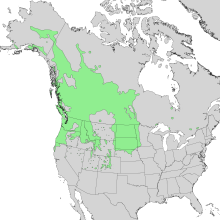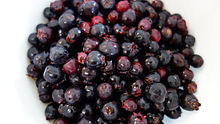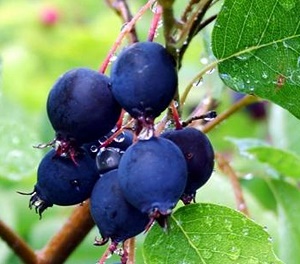
Looking for Saskatoons in 2025? Scroll down this page and follow the links. And if you bring home some fruit or vegetables and want to can, freeze, make jam, salsa or pickles, see this page for simple, reliable, illustrated canning, freezing or preserving directions. There are plenty of other related resources, click on the resources dropdown above. If you are having a hard time finding canning lids, I've used these, and they're a great price & ship in 2 days.
If you have questions or feedback, please let me know! There are affiliate links on this page. Read our disclosure policy to learn more.
Saskatoons and Juneberries - What They Are, Where to Get Them and How to Use Them!
 If
you live in western Canada or the far northern areas of the U.S (mostly in the
Northeast U.S., Great Lakes region and the northwest)., you may have heard of
Saskatoons, which are also called Juneberries or Serviceberries. Juneberries
grow wild across the northern U.S. and Canada. We will use the terms
interchangeably. The saskatoon cultivar (variety) is now being grown commercially
in Michigan and Canada. The commercial variety is a product of 30 years of
breeding in Canada.
If
you live in western Canada or the far northern areas of the U.S (mostly in the
Northeast U.S., Great Lakes region and the northwest)., you may have heard of
Saskatoons, which are also called Juneberries or Serviceberries. Juneberries
grow wild across the northern U.S. and Canada. We will use the terms
interchangeably. The saskatoon cultivar (variety) is now being grown commercially
in Michigan and Canada. The commercial variety is a product of 30 years of
breeding in Canada.
Saskatoons and Juneberries look much like a blueberry but are dark purple with an apple-like taste. Which makes sense because the saskatoon is a distant relative of the apple. Others say they taste like sweet black cherries or a mild blackberry. They have soft, tiny (and completely edible) seeds, which some say, give them an almond like taste, too.
Varieties
of Saskatoons / Juneberries
There are two primary species
- Amelanchier alnifolia, which is a commercial high-yielding species native to western Canada and the northwest US (see the map at right) and
- Amelanchier canadensis which is the wild shrub found in the Eastern US. (no map)
Picking tips:
Select plump, full saskatoons with a dark-blue purple color. A berry with any hint of light red isn't fully ripened. White and green colored saskatoons will not ripen after they are picked; while saskatoons that have already turned purple, red or blue-ish usually DO ripen after they are picked (if they are kept at room temperature to ripen).
Since saskatoons hang on the bushes in bunches a but like grapes do, the easiest and fastest way to pick them is hold your bucket under them in one hand and with your other hand, cup a ripe bunch and gently rub them with your fingers. The ripe berries will drop into your bucket, while the unripe ones will remain attached to the bush. I can easily pick 2 gallons per hour (if I'm not being distracted by the kids and the sun isn't too hot!). A newbie might do 1 gallon per hour.
Tips for storing Saskatoons after harvesting:
- Once picked, don't place the berries, still warm from the sun, in a closed bag or container. Leave the container open so moisture doesn't form in the container.
- Don't wash berries until just before using, to prevent berries from becoming mushy.
- Chill berries soon after picking to increase shelf life. Store your fresh saskatoons in the refrigerator as soon as you get them home, without washing them, in a covered bowl or storage container. If refrigerated, fresh-picked saskatoons will keep 10 to 14 days.
-
 Freeze berries in freezer containers without washing to keep
the skins from toughening. Place berries one layer deep. Freeze,
then pour the frozen berries into freezer containers. Because unwashed
saskatoons freeze individually, they can be easily poured from containers
in desired amounts. Remember both frozen and fresh berries should be
rinsed and drained just before serving. Just before using, wash the berries
in cold water.
Freeze berries in freezer containers without washing to keep
the skins from toughening. Place berries one layer deep. Freeze,
then pour the frozen berries into freezer containers. Because unwashed
saskatoons freeze individually, they can be easily poured from containers
in desired amounts. Remember both frozen and fresh berries should be
rinsed and drained just before serving. Just before using, wash the berries
in cold water.
Nutritional value of Saskatoons
Saskatoons/ Juneberries / Serviceberries are 18 % sugar, and
about 80% water, which is a lower moisture content than blueberries.
They are nutrient-dense, with high levels of protein, calcium, iron,
and antioxidants. Juneberries are an excellent source of iron
(almost twice as much iron as blueberries), relatively large amounts
of potassium (twice as much as blueberries); large amounts of
magnesium and phosphorous and high levels of phenolic compounds, anthocyanins.
|
Nutrients in raw saskatoon berries from Mazza, G. (2005). "Compositional and Functional Properties of Saskatoon Berry and Blueberry" |
||
| Nutrient | Value per 100 g | % Daily Value |
|---|---|---|
| Energy | 85 kcal | |
| Total dietary fiber | 5.9 g | 20% |
| Sugars, total | 11.4 g | 8% |
| Calcium | 42 mg | 4% |
| Magnesium | 24 mg | 6% |
| Iron | 1 mg | 12% |
| Manganese | 1.4 mg | 70% |
| Potassium | 162 mg | 3% |
| Sodium | 0.5 mg | 0% |
| Vitamin C | 3.6 mg | 4% |
| Vitamin A | 11 IU | 1% |
| Vitamin E | 1.1 mg | 7% |
| Folate | 4.6 µg | 1% |
| Riboflavin | 3.5 mg | > 100% |
| Panthothenic acid | 0.3 mg | 6% |
| Pyridoxine | 0.03 mg | 2% |
| Biotin | 20 µg | 67% |
Saskatoon berries contain significant amounts of total dietary
fiber, vitamins B2 (riboflavin)
and biotin, and the essential
minerals, iron and manganese, a nutrient profile similar to the
content of blueberries. For
more information, see this page on Cornell University's website.

Other Saskatoon Facts
The word Saskatoon comes from the Cree word "Mis-sask-quah-toomina" which sounded like "Saskatoon" to non-natives.
Growing Saskatoons
Saskatoons are a shrub-like bush which can grow as tall as 10 feet in height. The Saskatoon is a member of the apple family and is very hardy. The Saskatoon thrives in cold, dry weather. The harvest season typically starts in late June and ends in early July in most of the northern US and southern Canada. See these articles
- Growing Saskatoons
- Growing Juneberries/Saskatoons
- Saskatoon production manual
- Growing Saskatoons - A Manual For Orchardists
Cooking, Canning and Preserving Saskatoons
If you're looking for great, easy to follow recipes to make jam, jelly, freeze or make saskatoon pie from Saksatoons / Juneberries, see these pages:
- How to make saskatoon jam
- How to freeze saskatoons
- World's best and easiest saskatoon pie
- How to Can Saskatoons
- How to make saskatoon jelly
- How to make and can saskatoon syrup
- How to make home-canned saskatoon pie filling to use later
- Saskatoon buckle coffee cake: illustrated directions for this great crumb-topping saskatoon coffee cake
Looking for canning equipment and supplies?
Water bath canner with a jar rack
Pressure canners for gas, electric and induction stoves: Presto 23Qt or T-fal 22Qt
Canning scoop (this one is PERFECT)
Ball Blue book (most recent version)
Jars: 8oz canning jars for jams
Find Other types of farms:
Farm markets and roadside stands
Road trips and camping resources
Local Honey, apiaries, beekeepers
Consumer fraud and scams information
Home canning supplies at the best prices on the internet!
Maple Syrup Farms, sugarworks, maple syrup festivals
Environmental information and resources
Farms For Your Event for birthday parties, weddings, receptions, business meetings, retreats, etc.
Festivals - local fruit and vegetable festivals
Get the
most recent version of
the Ball Blue Book
With this Presto 23 quart pressure canner and pressure cooker, you can "can" everything, fruits, vegetables, jams, jellies, salsa, applesauce, pickles, even meats, soups, stews. Model 01781

You can make jams, jellies, can fruit, applesauce, salsa and pickles with water bath canners, like this Granite Ware 12-Piece Canner Kit, Jar Rack, Blancher, Colander and 5 piece Canning Tool Set

